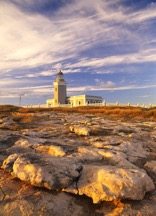As a travel photographer, I always have at least a couple of stories in mind when I travel to photograph a location. Regardless of how long my stay is, I never have enough time to photograph everything, so having themes helps me focus my photographic effort.
During a trip to Puerto Rico a few years ago, one of my photography themes was lighthouses. I had seen a number of published articles about the famous lighthouses of Maine (and elsewhere on the East Coast) but had never seen one about Puerto Rico, so I thought I had a good chance of getting such an article published. As always before a trip, I researched the history of the lighthouses: this information is useful not only to prepare for a trip but also later as you write the article.
According to my pre-trip research, the Spanish built 16 lighthouses around the 100 x 35-mile island before the U.S. annexation in 1898. Because our 10-day visit would not afford us enough time to photograph them all, I chose eight lighthouses based on their condition, location, and accessibility. I then rented a car in San Juan and traveled around the island to visit and photograph the selected lighthouses. By the end of the trip, I had a nice collection of lighthouse images, which I edited and captioned as soon as I returned home.
Because I enjoy writing about photography (I’m not a traditional travel writer), I first submitted my article idea—text, 20 carefully-selected images, delivery memo itemizing the enclosed images, and even a map of Puerto Rico showing where each lighthouse was located—to PhotoGraphic, a general interest photography magazine. My submission also included an “If You Go” section to make my query more appealing. The editors accepted the article for publication. And, about a year later, I was able to sell the same article (with a few changes) to Lighthouse Digest, a national magazine for lighthouse enthusiasts.
The following are five tips for getting your articles published in magazines:
- Have article ideas ready before you leave. Being focused on an article right from the start is helpful when taking photographs to illustrate the story, especially if you’re visiting a place for the first time, which can be overwhelming. Having said that, stay open to unexpected article ideas.
- Research before and during your trip. Research should not be limited to your pre-trip preparation. Talk to people on the ground about the subject you are photographing, read interpretive signs, collect maps and brochures. Muddy yourself with facts.
- When preparing your submission, follow the publication’s submission guidelines. Most magazines have these guidelines, which are usually posted on their websites. If not, ask for them via email. The guidelines will have useful information about how to submit (electronically vs. paper, sizing of images, etc.), when to expect payment (and how much), what kind of stories they are looking for, and much more.
- Be patient and persistent. Editors don’t always respond promptly to queries, especially when they come from people they don’t know. In general, wait a couple of months before sending a follow-up reminder, unless the magazine’s submission guidelines state otherwise (always follow the submission guidelines when available). If the magazine doesn’t accept your idea, move on and send it elsewhere. Rejection is part of the business and should not be considered defeat (defeat is not submitting the article in the first place).
- Do “the dance” when an article is accepted. Everyone has a victory dance, whether mental or physical. Don’t forget to do your dance when an article is accepted, but don’t dance too long. You need to prepare and submit another article.
[Editor’s Note: Learn more about how you can fund your travels and make an extra income with photography, travel writing, blogging, and more in our free online newsletter The Right Way to Travel. Sign up here today and we’ll send you a new report, Profit From Your Photos: A Quick-Start Guide, completely FREE.]



